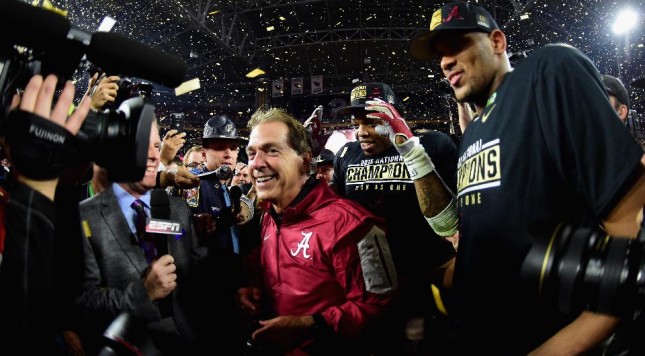It is quite true that in a few respects, the now-ended 2015 college football season was a lot like several others.
Alabama won the whole darn thing.
Nick Saban outcoached his peers.
A brand-name powerhouse won it all.
Of course, you knew those things already, much as you could rattle off several other obvious details which connect seasons as they come and go.
On a broader level, however, this college football season reinforced one of the central truths of the sport: A broader level doesn’t lend itself to many entrenched long-term verdicts on college football. This theater of competition just doesn’t allow itself to be shoehorned into a particular narrative label.
Here’s what I mean…
*
Yes, Alabama and Nick Saban won it all… again. It might seem to be a broken record, and it certainly feels that way for some, but understand how DIFFERENT this championship was, relative to Saban’s previous four, and his previous three titles in Tuscaloosa:
Saban won his first College Football Playoff title. This might not seem like that big a deal, but after last year, what was the big talking point?
“Alabama now has to play two top teams, not just one, to win the title, and it will be exposed to more of the competition. Had the BCS existed last season, Alabama would have played (and almost certainly beaten) Florida State. With the playoff format, the Tide had to play Ohio State and got smoked. This new system is going to be bad news for Bama. Saban’s run is winding down, or at least, it could stand on more tenuous footing than before.”
You saw a version of that line of thought — sometimes expressed with great severity, sometimes expressed with a very mild sense of cautiousness — at dozens of outlets across the country 12 months ago at this time.
It has been blown to bits. One playoff season in 2014 has given way to a different reality in 2015, year two of college football’s grand new postseason adventure.
Next…
*
Alabama didn’t win the way Alabama normally does.
For the first time in the Saban era, Alabama won an old-fashioned shootout in the title game. Giving up 40 points and still winning? That’s Saban’s mastery of the craft in evidence, but the old and longstanding idea that Alabama wins by punching an opponent in the mouth? It no longer holds. Clemson stood up to Bama in the trenches — that gives the Tigers little comfort in the wake of defeat, but in a few months, as this result sinks in, the ACC champions will gain more satisfaction from that fact.
Alabama — strictly within the confines of the regular season — was not that different in 2015 from 2014. The Tide were very unconvincing at times in SEC play. They were saddled with inconsistent quarterbacks from games one through 13 in each campaign. The difference? Whereas Blake Sims dissolved into a pool of turnovers against Ohio State, Jacob Coker put on his big-boy pants and played at a higher level, especially agianst Michigan State. He struggled for much of the evening against Clemson, but was nails in the fourth quarter, when quarterbacks have to be great (provided the game is close and the running game isn’t there).
If you felt the 2014 season taught you a given set of lessons about Alabama, its quarterbacks, its regular season form as a determinant of playoff success, and more, well… 2015 threw all those lessons out the window.
*
Then consider the 2015 season beyond Alabama and Saban for a little while.
Mark Dantonio and Michigan State pulled off Houdini after Houdini during the regular season. Having won four straight bowl games, three of them in highly improbable ways (2012 Outback in the overtime rollercoaster against Georgia; the late comeback against TCU in the December 2012 Buffalo Wild Wings Bowl; and then the 2015 Cotton Bowl comeback against Baylor), Michigan State figured to be the last team to get embarrassed in a playoff semifinal.
Well, ummm, about that…
That was just one plot twist of many in 2015.
Northwestern versus Stanford. Stanford versus Iowa. Iowa versus Northwestern. Try to make sense out of those three results.
Ohio State 49, Michigan State 37, in 2014, in East Lansing, with Connor Cook healthy.
Michigan State 17, Ohio State 14, in 2015, in Columbus, with Connor Cook not able to play.
Notre Dame, in 2014, could not withstand a flood of injuries to its defense. Notre Dame in 2015 was very much able to withstand a flood of injuries on both sides of the ball.
Oklahoma and Bob Stoops, just when the program and coach both appeared to be running on fumes, found new life.
The Pac-12 South, which showed so much progress in 2014, placed only one team in the top 38 of the polls (including the “votes” section) in 2015.
If 2014 gave us one view of the entire FBS landscape, 2015 gave us a very different one.
In 2016, the only thing we should expect is a season which will be very much unlike the previous one.
Think you know college football? The ultimate small-sample-size regular season in American sports is waiting to throw you a knee-buckling 12-to-6 curveball.
Say, when do pitchers and catchers report, anyway?

